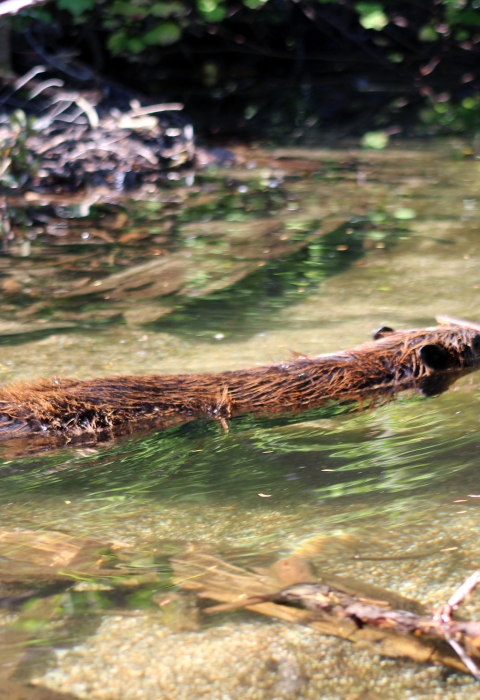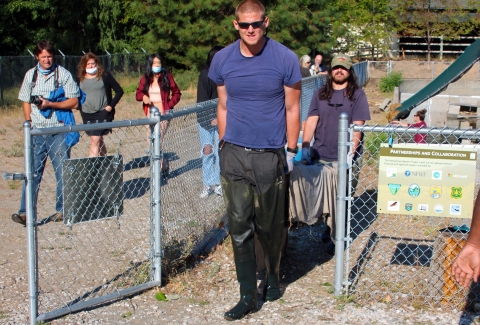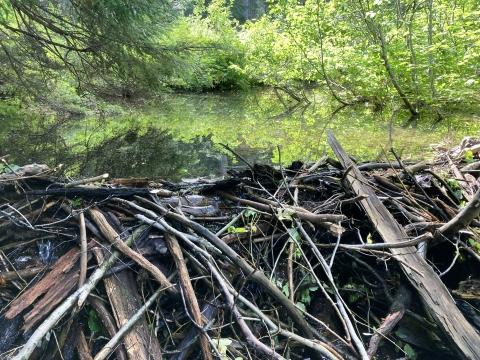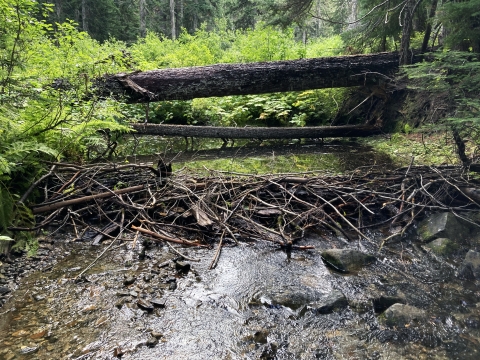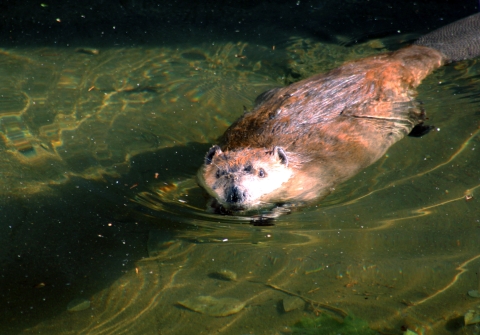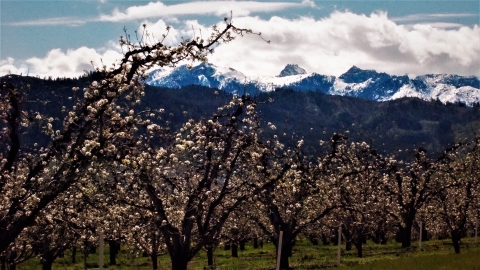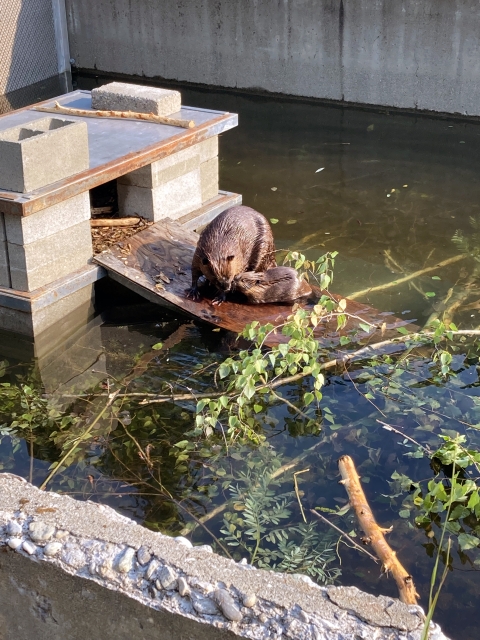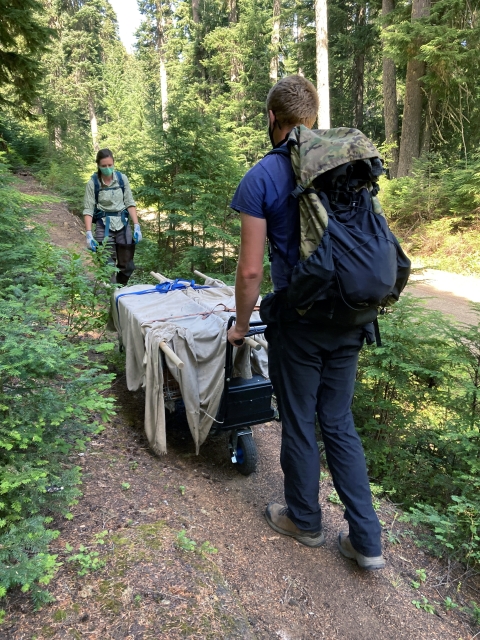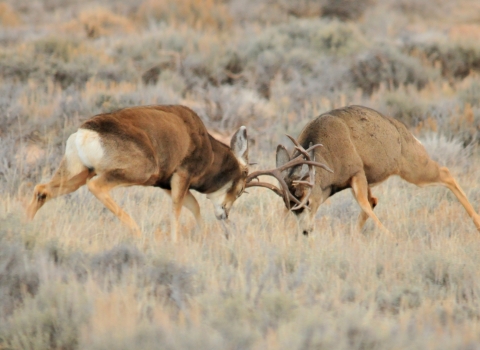On a sunny morning in late July, a small crowd forms around an uninhabited pond at the Leavenworth National Fish Hatchery. This pond, built in 1940 during the hatchery’s construction, has not held fish for decades; but today, the vintage structure structure
Something temporarily or permanently constructed, built, or placed; and constructed of natural or manufactured parts including, but not limited to, a building, shed, cabin, porch, bridge, walkway, stair steps, sign, landing, platform, dock, rack, fence, telecommunication device, antennae, fish cleaning table, satellite dish/mount, or well head.
Learn more about structure is receiving new tenants. The crowd parts as staff carry cages draped with wet towels through the gates of the holding pond. They open the cages, and two beavers timidly poke their heads out into the fresh summer air.
These mammalian guests, named Scar and Chewy by project staff, may at first appear out of place at a fish hatchery, but the beavers are integral salmon conservation partners. Beavers perform a variety of ecosystem services, including fish habitat restoration and climate change climate change
Climate change includes both global warming driven by human-induced emissions of greenhouse gases and the resulting large-scale shifts in weather patterns. Though there have been previous periods of climatic change, since the mid-20th century humans have had an unprecedented impact on Earth's climate system and caused change on a global scale.
Learn more about climate change mitigation; but when these animals build dams and forage on private property, conflict arises.
The relocation of Scar and Chewy is part of a collaboration between the US Fish and Wildlife Service (Service) and Trout Unlimited. The goal of the Wenatchee Beaver Project is to reduce conflict between beavers and landowners in Chelan and Douglas Counties, while helping support the important environmental benefits this unique mammal can generate. This is accomplished through the installation of non-lethal beaver deterrents where needed and the relocation of nuisance beavers from private to public land. These measures can help this important species continue to shape riverine habitat without disturbing local property owners.
Ecosystem Engineers
Kodi Jo Jaspers, manager of the Wenatchee Beaver Project, refers to beavers as “ecosystem engineers.” Aside from humans, beavers do more to shape their environment than any other species. These animals are not particularly fast or strong. Instead, they rely on their construction ability for protection from predators. Beavers use their sharp front teeth to harvest branches and trees as building material for their dams. A beaver dam creates a deep pond of water, at the center of which a beaver will construct its home. The pond then acts as a barrier between the beaver’s dwelling and potential intruders, much like a moat around a castle.
The Benefits of Beaver
Beaver dams benefit a multitude of other species, including cold-water-loving trout and salmon. Beaver ponds store cool water in summer, creating habitat for the region's important native fish species, like endangered steelhead and spring Chinook. This is especially important today with record high summer temperatures and longer periods of low flow conditions predicted to continue across the Pacific Northwest in coming years.
Additionally, beaver ponds store groundwater which fuels riverside vegetation. This vegetation, in turn, shades rivers and streams, further cooling the water for native fish. In many cases the stored groundwater also returns to surface flow in downstream reaches, providing important cool water to chill too-warm summer streams. This means that a healthy beaver population acts to conserve native fish species in the Wenatchee Valley, allowing future generations to witness iconic trout and salmon on this picturesque landscape.
Jaspers explains that beaver “affect our landscape on a big level when it comes to fire and climate resiliency.” Recent research suggests that beavers help to protect people and their property from wildfires. Riverside vegetation fed by beaver ponds acts as a fire break, stopping wildfires from advancing across the landscape. In 2021, twenty times more land was burned by wildfires in Washington and Oregon than in 2020. With increasing rates of wildfire in the region, beavers may be an important defense against fire-induced property damage and destruction.
Who was Here First? History of Beaver-Human Conflict
When painting a picture of the fauna of the pre-colonial North American West, one might imagine vast herds of bison, packs of wolves, and grizzly bears as far east as the Mississippi River. Beavers are often left out of that image, but historic population estimates put beaver at anywhere from 60 million to 400 million individuals. In the early 1800s, driven by an insatiable fur appetite in Europe coupled with depleted European beaver populations, trappers ventured westward in search of beaver. Like most furbearers, beaver produce a lush winter coat to stay warm during the coldest parts of the year. Desirable for garments, furs of all types were commercially harvested for sale.
By the early 1900s, beaver populations in North America had fallen to as few as 100,000 individuals. Due to their prolific breeding and reintroduction efforts, beaver populations are rebounding. Today, with managed populations and regulated seasons, trapping of beaver is sustainable. Modern trappers support conservation efforts and are often some of the biggest advocates for beavers; but these animals face new challenges now.
Once beavers were gone from much of their range and their habitat left unoccupied, human colonists took advantage of the flat, fertile valley bottoms. They converted wildlife-rich wetlands into agricultural lands and built towns nearby. In the Wenatchee Valley, much of the farmland is used to grow tree fruit, giving merit to the nickname “Apple Capital of the World.” Robes Parrish, a former restoration biologist for the Service, explained that beavers “like the Wenatchee Valley bottoms just as much as people do.” With rebounding beaver populations and increasing human population density, humans and beavers are occupying the same places.
Beavers “harvest trees, and people farm and harvest tree fruit here, so that’s why the conflict comes into play,” explained Parrish. Beavers building dams in areas populated by humans results in flooding, damage to valuable fruit trees, and damage to public infrastructure such as roads and culverts. Historically, this conflict often resulted in the lethal removal of beavers.
The Problems Relocation Solves
Trout Unlimited saw these conflicts from both human and non-human perspectives and found an opportunity to help the community. When faced with beaver conflicts in the past, landowners did not have many choices beyond lethal removal. In response, Jaspers said, “we are trying to change that and provide a non-lethal option and coexistence measures so that we can keep beavers on the landscape.” The Wenatchee Beaver Project offers free consultation to those in the valley experiencing beaver issues. Other beaver groups in the state, such as the Methow and Tulalip beaver projects, paved the way for this project.
Since its inception, the Wenatchee Beaver Project has successfully relocated 42 beavers to public land along the upper Wenatchee River. Through this project, Trout Unlimited strives to enhance cold-water fish habitat; and by using beavers as “restoration contractors,” this goal can be achieved in unique ways. Beavers have been constructing wetlands for millennia and are much more capable than humans at building productive habitat. By releasing beavers in vacant habitat throughout the watershed, the Wenatchee Beaver Project hopes to expedite the expansion of their range and ecosystem services in the Wenatchee Valley.
Temporarily housing beavers at the Leavenworth National Fish Hatchery allows the beavers to form family groups. Relocating a family group is more successful than relocating individuals. During this time, members of the community have the opportunity to see these furry architects up close. In this way, the Wenatchee Beaver Project is able to inform the public of the vital role that beavers play in the local ecosystem.
The Beaver Family Finds a New Home
Just as the sun breaks over the bluffs by the Columbia River, conspicuous ripples emanate from a Wenatchee Beaver Project trap set. A small beaver dives for cover but is stopped by the chain link of the suitcase trap. The young beaver, affectionately named Peach for the trees that abut the pond where it was captured, was the final piece of the beaver family needed for relocation. Chewy (a female captured at the same site as Peach) and Scar (a male captured a short distance away on the Wenatchee River) are the two adult beavers that will join Peach on their journey to a new home in a far-off, high mountain stream. Peach is brought up-valley to the Leavenworth National Fish Hatchery to join Scar and Chewy in awaiting relocation.
The Service is an invaluable partner for the Wenatchee Beaver Project. This partnership includes the use of the facilities at the Leavenworth National Fish Hatchery for housing beavers, as well as technical and field support from the Mid-Columbia Fish and Wildlife Conservation Office, helping to make this important project successful.
Now, with three beavers housed at the hatchery, Jaspers and her team of field technicians find themselves in the Wenatchee National Forest on a high elevation stream in search of suitable beaver habitat. As the drainage widens, the fir-dominated slopes give way to a large meadow rich in alders and berries. The streamside deciduous trees give project staff hope that beavers could make their home here. Beavers prefer deciduous trees, like alder and cottonwood, over resinous conifers, like pines and firs. The first survey of the creek reveals no recent beaver sign, but beavers could very well have occupied this stream in the past. The ample pools and log jams will provide perfect anchoring points for beavers to build their dams. A deep, shaded pool within the area is chosen for the release site.
On a sunny day in early August, the beavers are brought to their new home. After a bumpy ride on a U.S. Forest Service road, Chewy, Scar, and Peach are transferred from the bed of a truck to a gardening cart and wheeled half a mile to the release site. One by one, they slip into the stream and paddle off.
Living With Beavers Through On-Site Management
Although the Wenatchee Beaver Project has had success with relocation, the project team aims for on-site management when possible. Solutions as simple as caging desirable trees or painting tree trunks with gritty paint can deter beavers from chewing. When flooding is an issue, “beaver deceivers” are installed. A beaver deceiver consists of a large pipe put through a beaver dam and caged at both ends. Like a culvert underneath a road, the pipe allows water to flow through, and the cages prevent beavers from plugging the ends. This device will keep the water level in a beaver pond from exceeding a desired depth. If these methods are impossible to apply, then trapping and relocation are used as a last resort.
In early October, greeted with snowfall instead of sunshine, staff from Trout Unlimited and the Service take a hike back to the Wenatchee National Forest to check on Chewy, Scar, and Peach. They find huge swaths of alders trimmed to the ground. Like the riparian riparian
Definition of riparian habitat or riparian areas.
Learn more about riparian forest, the staff are leveled by the amount of work done by these three beavers in just a few short months. Two impressive dams stretch across the creek, ponding several hundred feet of water. These feats of beaver-powered engineering are already improving important aquatic habitat, which directly benefits fish and wildlife species in the area and adds important resiliency to a watershed already stressed by a changing climate. As the Wenatchee Beaver Project team leaves the stream, they spot a lone trout listing through one of the massive beaver ponds, sure to benefit from its new neighbors.
Sarah Ortiz was a Student Conservation Association intern in 2021 with the Mid-Columbia Fish and Wildlife Conservation Office. Michael Dello Russo works for Trout Unlimited on the Wenatchee Beaver Project.
